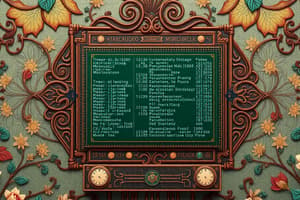Podcast
Questions and Answers
What are the four components of a computer system?
What are the four components of a computer system?
Hardware, Operating System, Application programs, Users
Which of the following is not a goal of an operating system?
Which of the following is not a goal of an operating system?
- Make solving user problems easier
- Use hardware efficiently
- Increase hardware costs (correct)
- Execute user programs
An operating system acts as an intermediary between a user and the computer hardware.
An operating system acts as an intermediary between a user and the computer hardware.
True (A)
The local buffer is managed by the ___.
The local buffer is managed by the ___.
What does the term 'OS' stand for?
What does the term 'OS' stand for?
What is the primary purpose of caching?
What is the primary purpose of caching?
Each __ is in charge of a particular device type.
Each __ is in charge of a particular device type.
How is the term 'interrupt' defined in the context of operating systems?
How is the term 'interrupt' defined in the context of operating systems?
Match the storage units with their corresponding bytes:
Match the storage units with their corresponding bytes:
The operating system does not need to manage resources efficiently.
The operating system does not need to manage resources efficiently.
Study Notes
Course Outcome – Unit 1
- Learn to compare various CPU scheduling algorithms based on arrival time, burst time, and turnaround time.
Fundamentals of Operating Systems
- A computer system comprises four main components: hardware, operating system, application programs, and users.
- Hardware: Includes CPU, memory, and I/O devices.
- Operating System: Coordinates hardware use among applications and users.
- Application Programs: Define how system resources solve user problems (e.g., word processors, web browsers).
- Users: Can be individuals, machines, or other computers.
Operating System Definition
- Acts as an intermediary between users and computer hardware.
- Goals include executing user programs, simplifying problem-solving, and efficient hardware usage.
- Functions as a resource allocator and ensures fair resource use among conflicting requests.
- Serves as a control program that prevents errors and improper usage of the computer.
Computer System Operation
- Operation involves multiple CPUs and device controllers connected via a bus to access shared memory.
- Concurrent execution occurs, allowing I/O devices and CPUs to operate simultaneously.
- Device controllers manage specific device types and contain local buffers for data transfer.
Interrupts
- Interrupts transfer control to the interrupt service routine using an interrupt vector.
- They help preserve the CPU's state by saving registers and the program counter during interruptions.
- Two types of interrupts exist: polling and vectored interrupt systems, each requiring specific handling code.
Byte Storage Notations
- Key metric conversions for digital storage:
- 1 byte (B) = 1
- 1 kilobyte (KB) = 1,024 bytes
- 1 megabyte (MB) = 1,048,576 bytes
- 1 gigabyte (GB) = 1,073,741,824 bytes
- 1 terabyte (TB) = 1,099,511,627,776 bytes
- 1 petabyte (PB) = 1,125,899,906,842,624 bytes
- 1 exabyte (EB) = 1,152,921,504,606,846,976 bytes
- 1 zettabyte (ZB) = 1,208,925,819,614,629,174,706,176 bytes
- 1 yottabyte (YB) = 1,180,591,620,717,411,303,424 bytes
Storage Structure
- Main Memory: Volatile, directly accessible by the CPU, supports random access.
- Secondary Storage: Non-volatile, serves as an extension of main memory, allows larger storage capacity.
- Magnetic Disks: Comprise rigid platters, organized into tracks and sectors, with disk controllers managing data interactions.
Storage Hierarchy
- Organized by speed, cost, and volatility.
- Caching involves copying data to a faster storage medium, positioning main memory as a cache for secondary storage.
- Device drivers for each controller ensure a uniform interface with the kernel for effective I/O management.
Studying That Suits You
Use AI to generate personalized quizzes and flashcards to suit your learning preferences.
Related Documents
Description
This quiz covers the fundamentals of operating systems, focusing on CPU scheduling algorithms. It includes comparisons based on processes' arrival time, burst time, and turnaround time. Perfect for students looking to deepen their understanding of Operating System concepts.




